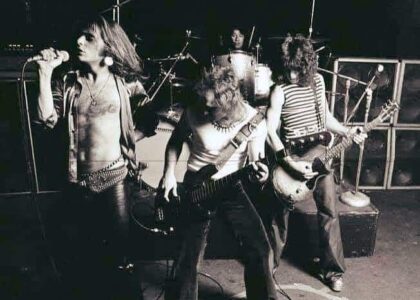I was 16 years old when a video came out that sparked a revolution. It was an Eddie Murphy concert video called Delirious, and when it was released in 1983, it was 69 minutes that changed stand-up comedy, maybe forever. You could say it inspired a generation, or you could say it took a wrecking ball to an art form.
Stand-up comedy certainly wasn’t new. Comedians had been on television for decades. There was a long road to get there, too, paved by the likes of Bob Hope and Mort Sahl. Other luminaries would follow, like Richard Pryor and George Carlin. But, especially for edgier comics like Lenny Bruce, standup was mostly reserved for smoky nightclubs, albums, or for the lucky ones who were family-friendly, six-minute chunks on late-night television. In fact, a comedian’s entire future could be virtually guaranteed by a single successful appearance on Johnny Carson’s version of The Tonight Show.
And let’s not forget Steve Martin. Off the success of albums in the 1970s like Wild And Crazy Guy and Let’s Get Small, Steve Martin was selling out 20,000-seat arenas as if he were Aerosmith. Comics were held up as geniuses, and wry commentators on the human condition.
That kind of genius often showed up disguised as comedy. When the iconic American TV series, All In The Family, premiered in 1971, the real source of the comedy was in Carroll O’Connor’s character of Archie Bunker, who was constructed as a parody of the absolute worst character traits of America. Every once in a while, Archie had to do kind things to prevent the audience from absolutely loathing him, but he existed primarily as a black mirror for America. What was unfortunate, and probably the thing that would prevent All In The Family from being produced as a first-run series today, is that some people didn’t see Archie as a parody. They looked at Archie and saw themselves. And not even selves that they were ashamed of.
Over and over again, there are examples through the 1950s, 60s and 70s of comics as commentators.
Then came Delirious.
The genuine comedic genius of Eddie Murphy, combined with an incredible command of the stage and near perfection in comic timing, meant that Eddie Murphy was the new definition of both cool and funny. Every young guy – blacks and whites alike – wanted to be Eddie Murphy. You could go to your friends and say, “goonie goo-hoo”, and there would be instant recognition and community. Eddie Murphy’s “goonie goo-hoo” was the 1980s version of Budweiser’s “Whazaaaaaaap”.
Eddie Murphy had given rise to the comedy industry. You could argue the success of Delirious even spawned an entire genre of television channel – the comedy stations, a genre that was basically dominated by HBO, both with their late-80s series, One Night Stand, and other projects like Comedy Central. The endless supply of comedy on television and video created an insatiable demand for live stand-up comedy in night clubs.
Enter the wrecking ball.
Make no mistake – there’s some hilarious stuff in Eddie Murphy’s Delirious that still makes me howl. But in those 69 minutes, Eddie drops the F-bomb 230 times, and what I guess we’ll call “the s-bomb” 171 times. So on average, one of those two words pops up about every ten seconds, for more than an hour.
So by the middle 1980s, there was a “comedy night” happening somewhere in your town, pretty much every night of the week. Dedicated comedy clubs were running six or seven nights a week, and restaurants that had no business as a live entertainment venue were hosting comedy shows with makeshift stages shoehorned into awkward corners of the dining room, or even surrounded by the driftwood fence that usually served as the dance floor in your local country bar.
With demand comes supply.
The Eddie Murphy wrecking ball meant that we went from wry commentary and examination of the human condition, to an exhausting barrage of crotch-grabbing and f-bombs from “goonie goo-hoo” wannabes and practitioners of the craft who really didn’t belong there. As a result, the craft suffered for a long time until the Jerry Seinfelds and Paul Reisers of the world brought us at least part of the way back from the time of The New Neanderthals.
Sure, Carlin and the rest were still out there performing, and releasing HBO specials and concert videos, but on any given night in a comedy club, it was, if you’ll pardon the pun, a “Dice” roll as to whether you were going to see something worth the price of admission. (And yes, I’m intimately aware that Andrew “Dice” Clay is the same kind of parody as Archie Bunker. I was in the room while the “Diceman” character was still being developed. My old friend Mark Breslin gave him his first network television spot, on The Joan Rivers Show.)
Not that long ago, I went to a comedy club in Vancouver, Canada. The host came on and brought on the first “comic”, who at the fifteen-SECOND mark of his “act” had already made a reference to having intimate relations with a dog. I wonder… does that guy get anywhere near a comedy stage without the butterfly effect created by Delirious forty years earlier?
And don’t think that’s limited to comedy, or that it has become a modern phenomenon fueled by the internet and social media. The Beatles spawned literally thousands of soundalike and lookalike bands, most of whom lacked the musical genius that made The Beatles special. Survivor basically invented the genre of reality television, which led to a whole pile of… well… mostly garbage. I’d say that out of every twenty reality television shows that actually see the light of day, maybe one is actually worth investing time in.
Regular listeners to The Voice In My HED know that I love beating a point to death by giving enough examples to choke a horse. So with that, I’ll introduce you to my friend Gabby. Gabby works in the town I’m staying in, at a cool little restaurant called The Surly Mermaid. Which might be one of my favorite names ever. And even though she’s not normally the bartender at The Surly Mermaid, she’s now my favorite bartender of all time. Why? A hundred little things. The second time I sat at the bar, she called me by name. Remembered my drink order with exact detail. Brought up tiny bits and pieces of conversations we’d had the time before. Knew exactly when to engage, and when to let things breathe. Made me feel like a regular. More than that, made me feel like we were friends. Like I mattered.
What I realized is that I had been taking bartenders largely for granted. Because in my experience, the overwhelming majority of bartenders are merely competent. They can put liquids into a glass and get it into your hands without injuring themselves or others. What happened was that as it applied to bartenders, mediocrity had become the norm. I was so used to being underwhelmed by average servers that anyone who remembered what I was drinking when it was time for the second round seemed like a rock star.
Enter Gabby.
Suddenly I was reminded what an actual great bartender was like. Which, on the one hand is terrific, because I got to have that experience. On the other hand, it kinda sucks, because wow were a lot of people getting heavy tips who maybe needed to invest the tip money in some proper training or seasoning. If you’re ever on Canada’s Vancouver Island, maybe look Gabby up and see if she’ll teach you the tricks of the trade.
So let’s look at the pendulum vs wrecking ball metaphor as it applies to podcasting.
There’s a terrific guided meditation out there from a coach named Jeff Warren – it’s actually a bespoke meditation he created specifically for singer Josh Groban, designed to get him “unstuck” and free up the parts of his brain responsible for creativity. In the session, one of the things Jeff talks about is really leaning into the idea of “not doing”, and focusing not so much on the breath as that brief pause between the end of the out breath and the beginning of the next inhale.
That’s where I think podcasting’s momentum is right now, whether you’re invoking the metaphor of either a pendulum or a wrecking ball. It’s at that brief moment in time when motion in one direction has slowed, stopped, and is about to go back I. The other direction.
I can’t tell you the number of people in the corporate podcasting space, which is where I mostly hang out lately, who talk about the challenges that part of the industry is facing. Part of it is the reality of business, where on of the sad, ageless truisms is that when economic times are uncertain, the first thing to get cut is the marketing and advertising budget, even though in reality it’s the LAST thing that should be cut. But part of it is that a ton of podcasts have been started in the last several years without anyone stopping to ask the question, “Should we even be DOING a podcast? And if we should, should we be doing it without help?”
I’ve said before that technology has made it easier than ever to start a podcast. But I’ve also said that just because everybody CAN do a podcast, doesn’t mean that everybody SHOULD.
There might be no one on the planet better at being the guiding hand for a corporate podcast than my friend Roger and his team at JAR Audio. And when you really sit down and talk to them about their approach and their philosophy, the Eddie Murphys of the podcast space really start to stand out like sore thumbs.






